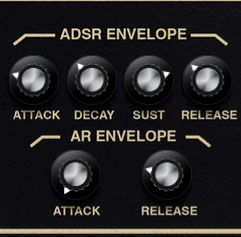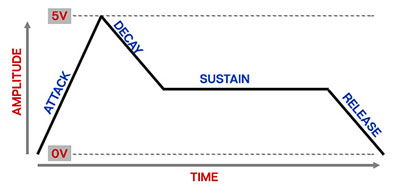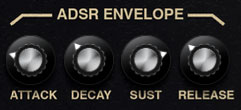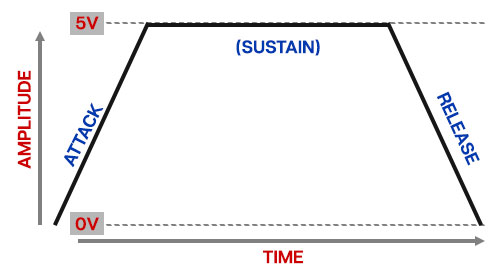
Pro-Soloist includes two envelope generators - a standard ADSR (attack/decay/sustain/release), and an AR (attack/release). These are most often used to modulate the VCA for shaping the amplitudes of notes, but also can modulate a number of other destinations using the cream-colored sliders and the Mod Matrix.
ADSR Envelope Generator
If you're not familiar with how envelope generators work, here's a CliffsNotes explanation of how an ADSR works... a real conversation starter at parties!

When Pro Soloist sees a gate voltage from a note, the envelope generator outputs a dynamically changing voltage, according to the settings of its four stages. The attack stage defines how long it takes for the output voltage to rise from 0 to 5 volts. Once the attack stage reaches 5V, it moves to the decay phase, which defines how long it takes to fall from 5V to the setting of the Sustain phase. Unlike the attack, decay, and release phases, which define times, sustain simply sets the held voltage level following the attack and decay phases - this equates to the envelope output level while holding down a key. Finally, the release slider defines the the length of time it takes for the voltage to fall back to 0V when the gate input voltage is removed, i.e. when the key is released.

Attack- Defines the length of time for voltage to rise from 0V to 5V when a key is played.
Decay- Defines the length of time for voltage to fall from the attack stage 5V peak to sustain stage setting.
Sustain- Sets the voltage level following attack and decay phases while a note is held.
Release- Defines the length of time for voltage to fall from sustain level to 0V when a key is released.
AR Envelope Generator
A simple envelope generator with attack and release segments only. Pro Soloist's AR envelope could more accurately be labled an ASR - attack-sustain-release envelope, because the voltage holds at 5V when key is held.
The AR envelope functions as follows:

The attack stage defines how long it takes for the output voltage to rise from 0 to 5 volts. Once the attack stage reaches 5V, it remains there until the key is released. The release control defines the length of time it takes for the voltage to fall back to 0V when the gate input voltage is removed, i.e. when the key is released.

Attack- Defines the length of time for voltage to rise from 0V to 5V when the gate voltage is applied.
Release- Defines the length of time for voltage to fall to 0V when a key is released.